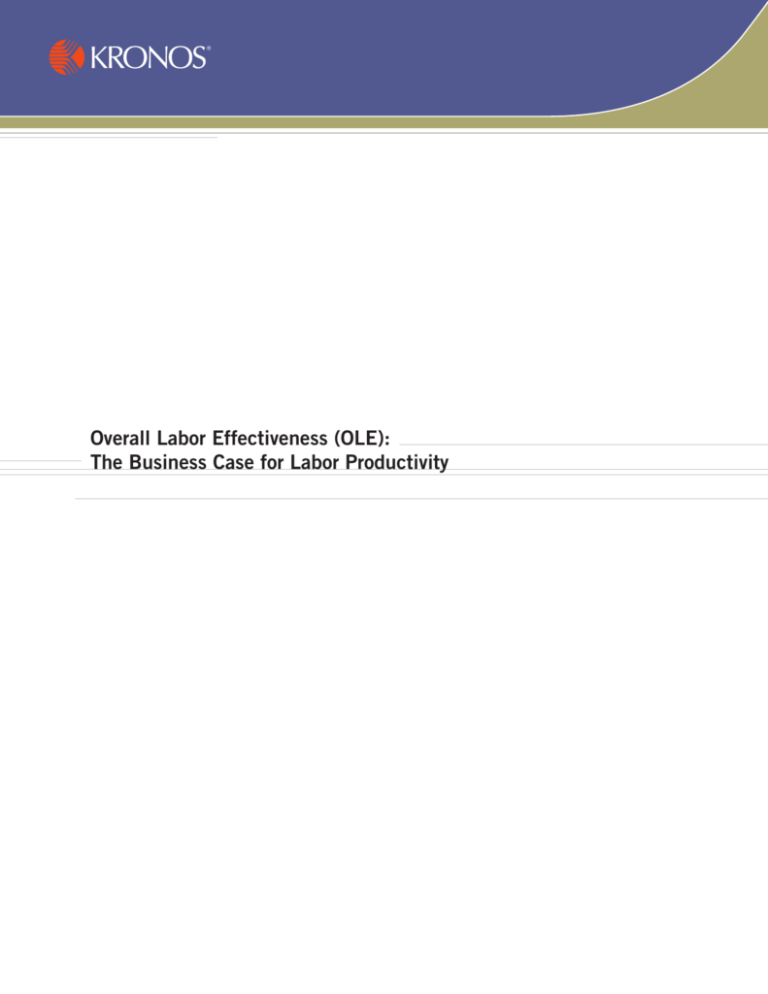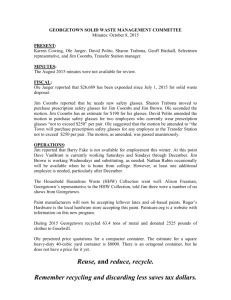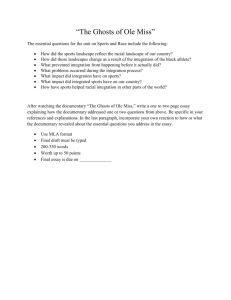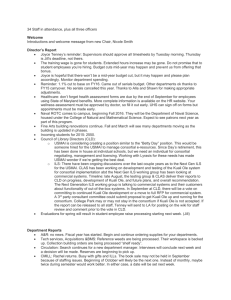
Overall Labor Effectiveness (OLE):
The Business Case for Labor Productivity
Overall Labor Effectiveness (OLE):The Business Case for Labor Productivity
Using OLE to find productivity leaks and create profit opportunities
When it comes to workforce issues, perhaps no industry is under more pressure than manufacturing. The
challenges include front-page topics such as massive outsourcing to low-cost countries, unions, an aging
workforce, and healthcare and family issues.
Having already automated many aspects of production and supply chain operations, manufacturers
now recognize that the next frontier for high performance is the workforce. While most companies have
automated core HR functions, many are just beginning to invest in strategic applications to rationalize the
impact of the workforce on productivity and ultimately, profitability.
Overall Labor Effectiveness™ (OLE), the model and toolset pioneered by Kronos, provides a window
into workforce productivity. Kronos OLE tools expose the impact of both direct and indirect labor so
companies can take action to reduce costs and identify opportunities for increasing overall productivity
and profitability.
OLE gives companies the ability to analyze the cumulative effect of three workforce factors on
productive output:
•Availability: the percentage of time the workforce spends making effective contributions
•Performance: the amount of product delivered
•Quality: the percentage of perfect or saleable product produced
Profit
Quality
plo
Em
Availability
rod
P
yee
The Manager’s Challenge:
ty
ivi
uct
How do I know what
drives the difference?
Loss
Performance
Improvements made to any one of these factors can have an enormous influence on profitability. The
historical challenge for many manufacturers has been to avoid the unintended consequences that can
result when efforts to improve in one area have a rebound effect. For example, an initiative to improve
quality might end up impairing output performance by slowing down the production line. OLE helps
expose these interrelationships and provide a real-time view of progress, so managers can keep all three
measures in balance.
Overall Labor Effectiveness (OLE):The Business Case for Labor Productivity
Let’s look at an example of how OLE can
be effective in diagnosing performance and
improving profits.
In preparing an annual budget, a COO
started by using current standards
to draft plans for projected production
volumes. This resulted in cost of goods
sold (COGS) of $116M and an expected
gross margin of 6.25 percent. COGS was
broken down as shown in the pie chart.
Materials
24%
Labor
10%
Overhead
66%
It didn’t take the COO long to find that tweaking the numbers for labor availability, performance, and
quality by just one percentage point each made gross margin jump to 8.15 percent and profit surge by
$2.5M. The challenge, of course, was to find where the necessary improvements could be made.
The COO knew a reduction in headcount was not the answer; the skills and experience of the existing
workforce were far too valuable to lose. He needed to assess performance at every level of the organization,
and fortunately he had the tools of OLE to help him identify meaningful opportunities.
The OLE Lifecycle: Corrective action and productive advantage
Attacking labor productivity using the OLE lifecycle typically involves two important phases. First, manufacturers focus on problem areas to achieve at least the current standard or planned output. Next, they
strive for productivity advantage in a phase that continues their diagnostic work, fine-tuning the elements
of OLE and raising workforce productivity to industry-leading or competitive advantage levels.
From his analysis, the COO knows that small changes can add up fast. Resolving day-to-day issues that
may seem minor can make a big difference to productivity and profitability. By quantifying the costs and
opportunities of the issues exposed by OLE, improvements to the bottom line can be identified.
The OLE Lifecycle
Corrective Action Phase
Productivity Advantage Phase
tput
ure
re
• Attendance/absenteeism
• Skills development
• Temp workforce
scheduling
Profitable
Output Level
Overall Labor Effectiveness (OLE):The Business Case for Labor Productivity
Getting started: Identifying productivity leaks creates immediate opportunities
The COO knows that while OLE provides an excellent top-level view of labor effectiveness, its true value is
with the underlying layers, where it can be used to help uncover the root causes of productivity leakage.
Using Kronos OLE tools, he examines the labor dimension of operations (availability, performance, and
quality) at the corporate, plant, department, and operator levels, and compares it to productive output,
looking for patterns of inefficiency to surface.
Availability
Availability is the place to start, because the workforce has already been hired. Now the objective is
to locate areas where providing and scheduling the right mix of employees will increase the number of
productive hours. Having the right people at the right time may seem like a basic point, but without it, all
bets are off for the rest of the workforce productivity equation.
The COO looks through time-sequenced Kronos data for evidence of sandbagging — arbitrarily reducing
the number of planned productive hours per employee to protect an achievable manufacturing schedule.
Next, he examines absenteeism and unapproved leaves. Kronos labor data, when automatically compared
to production output, pinpoints differences among production lines. A review of production operations
shows that inefficient layout and materials delivery lead some operators to leave their workstations to get
materials themselves, cutting into their productive time. Lax supervision that fails to return workers to
their workstations promptly after breaks further cuts into availability.
The company relies heavily on temporary labor to deal with substantial seasonal demand changes and
unpredictable peaks and valleys caused by new products. By examining Kronos headcount trend data and
correlating it to actual production output, the COO finds that the company is keeping temporary workers
on board longer than necessary. Further checking identifies an easily remedied information bottleneck that
is slowing staffing cuts when demand falls.
Production — Labor Resources Analysis
50,000
40,000
Production Hrs
30,000
Full-Time
Employee Hrs
20,000
Temporary
Employee Hrs
Q1
Q2
Q3
Q4
December
November
October
September
August
July
June
May
April
March
February
January
10,000
Overall Labor Effectiveness (OLE):The Business Case for Labor Productivity
The COO’s OLE research also exposes a pattern of unanticipated productivity shortfalls, namely the
inefficient use of available resources. A look into the deeper layers of OLE data shows that the leakage
is also related to indirect labor activities. There are substantial wait time losses while workers wait for
production line changeovers and a safety inspector certifies changed configurations. By talking with floor
supervisors, the COO finds that it takes significant management and supervisory attention to get lines
changed over or started up, a costly situation given the company’s demand patterns. And these issues
often trigger unanticipated overtime expenses. The COO establishes a corrective action project, setting a
quantified goal for improving changeover productivity.
By applying his knowledge of the company to the following assumptions, the COO can list and quantify the
productivity losses related to availability to be between 1.3 and 2 percent, or an impressive $1M–$1.6M.
Area
Direct Labor
Availability Factors
•Low labor standard — schedule protection
•Absenteeism
Potential Net Benefit
1% –1.5% increase in
scheduled productive time
•Slow start-up after breaks
•Slow release of unneeded temps
Indirect Labor
•Realign material handler tasks
0.3% – 0.5%
•Insufficient safety inspectors
•Too much management intervention or
approval required for consistent production
Performance: Getting the best output from your workforce
Making the assumption that the right workforce is available and properly scheduled, the COO turns to
factors that influence labor performance. Kronos trend data of shift and individual worker performance,
when matched through OLE tools to employee training records, can disclose differences in how long it
takes new workers to become productive. The data also relates productivity to the timing and content
of the training new workers receive and shows that workers on some lines get up to speed faster. This
prompts the COO to visit the shop floor, where he finds written work procedures posted at the workstations
of the more productive lines. OLE also shows that there are more production stops for in-line test equipment repairs on lines that have newer workers, leading to excessive maintenance overtime and occasional
delays on other lines.
Overall Labor Effectiveness (OLE):The Business Case for Labor Productivity
Area
Direct Labor
Performance Factors
Potential Net Benefit
•Single classroom training vs. multiple OJT task
training sessions at workstation
0.5% – 0.8%
•Procedures posted at workstation
Indirect Labor
•Production stops due to improper use of
in-line test equipment
0.5% – 0.8%
•Production delays caused by broken in-line
test equipment
•Excessive maintenance overtime
Quality: Ensuring what’s built isn’t wasted
By considering the workforce fully available and capable of sustaining the right output levels, the COO
turns his attention to ensuring that workers deliver the highest quality output. Nothing is more wasteful
than investing time and material in a product that must be scrapped or reworked.
Production data shows that the overall scrap rate is on target, but OLE exposes that a single shift — one
supervised by an employee recently hired from a competitor — is wasting fewer materials at start-up and
changeover. The COO calculates the benefit of transferring that process knowledge to all shifts.
Quality Performance by Shift Supervisor
96.0%
95.8%
95.6%
95.4%
Arifin,
Blake
Bennetts,
John M
Bockenkamp,
Gabriel L
Bohling,
Michael L
Brooks,
John R
Brown,
Carolee J
Overall Labor Effectiveness (OLE):The Business Case for Labor Productivity
A new test method has been introduced and approved at the plant, in part because it promises faster
analysis for quality assurance and requires fewer materials. However, a comparison of individual worker
productivity to the phase-in of the test shows that the more complicated test took longer for even the most
skilled production workers to complete. Overall, it actually increased costs.
Area
Quality Factors
Potential Net Benefit
Direct Labor
•Lower scrap rate on all shifts by applying
supervisor’s process knowledge to all
0.4% – 0.7%
Indirect Labor
•Revert to old test method
0.3% – 0.7%
At this point, the COO has found ways to improve output and quality by increasing the flexibility and costeffectiveness of the workforce. He has identified corrective actions to bring operations up to standards
and in some cases found ways to increase the standards. Overall he has identified a total of 3 to 5 percent
improvement in labor costs.
Productivity: Tuning for a profitability advantage
Once an organization has instituted many of the basic changes identified by the OLE model, it can begin
looking for opportunities to optimize workforce performance across all manufacturing operations. Kronos
OLE tools are an enormous help in identifying productivity leakages, but they bring special power to
spotting and correlating more complex labor-related challenges. Advanced application of OLE
looks at interdependencies among organizations and processes. The search can uncover specific
bottlenecks — third-shift productivity lags when the only certified maintenance technician is absent — or more general problems — employees who regularly attend mandatory training are more
productive than those who claim to be too busy to attend.
The OLE Lifecycle
Corrective Action Phase
Productivity Advantage Phase
• Higher output
• Improved cost structure
• Improved margin capture
•
•S
• Te
sch
Profitable
Output Level
Overall Labor Effectiveness (OLE):The Business Case for Labor Productivity
Identifying productivity improvement opportunities
Because every company is different and faces unique challenges to productivity and profitability, OLE
can be used in many ways. In our example, the COO investigated two areas that could lead to
better profitability.
Analysis of call center and field service labor data showed that field service costs were unusually high for
a particular product line. By relating these unplanned costs to production and design costs, the COO had
a clearer picture of product profitability and was able to make better and more strategic product selection
and pricing recommendations. He also instituted a program to improve quality at the factory level.
The company had outsourced some of its production operations and, by using OLE tools, the COO learned
the outsourcing was not delivering expected benefits. Although outsourced labor rates were excellent, the
costs had shifted to the indirect side. The task of managing the outsourcing, including costs for product
managers, travel and communication, product transportation, and management attention, were all higher
than expected. The COO entered the next round of negotiations armed with much better information.
Summary
Manufacturers have made great strides in optimizing materials usage by implementing powerful supply
chain applications, but the labor side of the equation, which concerns a company’s most vital and
controllable resource, has been largely neglected. Companies have invested in basic HR functionality, but
are missing the productivity rewards that can result from optimizing labor availability, performance, and
quality of work.
Adopting OLE metrics can give a company the fuel it needs to capture significant cost savings and improve
its market competitiveness. OLE brings balance to the manufacturing equation of labor and materials;
harnessing information about the interactions between them opens new windows of opportunity.
Kronos Incorporated 297 Billerica Road Chelmsford, MA 01824 (800) 225-1561 (978) 250-9800 www.kronos.com
©2007, Kronos Incorporated. Kronos and the Kronos logo are registered trademarks and Overall Labor Effectiveness and “Experts at Improving the Performance of People and Business” are trademarks of Kronos
Incorporated or a related company. All other product and company names mentioned are used for identification purposes only, and may be the trademarks of their respective owners. All specifications are subject
to change. All rights reserved. Printed in the U.S.A. 5107-34906A






